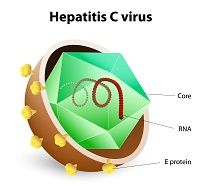Article
Improved Outcomes in Patients with Chronic Hepatitis C Treated with Sofosbuvir Velpatasvir
Author(s):
Treatment with fixed-dos combination sofosbuvir/velpatasvir yielded significant improvements in patient-reported outcomes.

“Sofosbuvir (SOF)/velpatasvir (VEL) is a new pan-genotypic regimen for hepatitis C virus (HCV) infection that has been associated with high efficacy. The goal of this study was to assess patient-reported outcomes (PROs),” said Zobair Younossi, MD, of the Center for Liver Disease, Department of Medicine, Inova Fairfax Hospital, at a presentation at Digestive Disease Week 2016, a joint meeting of the American Academy for the Study of Liver Diseases (AASLD), American Gastroenterological Association (AGA), the American Society for Gastrointestinal Endoscopy (ASGE), and the Society for Surgery of the Alimentary Tract (SSAT).
Patients with HCV infection often experience severe fatigue that impacts their health-related quality of life and work productivity. Previously used interferon-based regimens added to the impairment during and shortly after treatment. Newly developed interferon-free HCV regimens not only successfully clear the HCV virus but may also improve a number of different patient-reported outcomes.
In the ASTRAL-1 clinical trial, a phase 3, multicenter, multinational, blinded, placebo-controlled trial, patients with HCV genotypes 1-2 and 4-6 were randomized to receive either a fixed-dose combination of 400 mg/100 mg of SOF/VEL or matching placebo once daily for 12 weeks. This fixed-dose combination has been shown to be highly efficacious in HCV genotype 1-6 patients in a series of ASTRAL studies. Here, four different instruments, including the Short-Form 35 (SF-36), Functional Assessment of Chronic Illness Therapy-Fatigue (FACIT-F), Chronic Liver Disease-HCV (CLDQ-HCV), and Work Productivity and Activity Improvement-Specific Health Problem (WPAI:SP), were used to assess patient reported outcomes at baseline, during treatment, and up to 24 weeks of follow-up.
Patient-reported outcomes began to improve shortly after initiation of treatment with SOF/VEL, particularly in general health, emotional well-being, and by Week 4, all five domains of CLDQ-HCV had significantly improved by as much as 7.2 points on a scale of 0 to 100 (p<0.05). These improvements continued, with up to 8.2 point increased seen at Week 8 (p<0.05 for 12 out of 25 PROs) and up to 8.5 points by treatment Week 12 (p<0.05 for 16 out of 25 PROs).
After treatment discontinuation, the improvements continued with increases of up to 9.5 points, 9.7 points, and 11.8 points by post-treatment weeks 4, 12, and 24, respectively. These results are in stark contrast with the flat or moderately decreased PROs observed during treatment with placebo.
Treatment with SOF/VEL yielded significant improvements in patient-reported outcomes, even after adjustment for gender, history of psychiatric disorders, type 2 diabetes, cirrhosis, and treatment history. Finally, patients who achieved sustained virologic responses also tended to experience improvements in patient-reported outcomes.
“The pan-genotypic regimen with a SOF/VEL fixed-dose combination has not only excellent efficacy but also has a significantly positive impact on patient experience during treatment and after receiving sustained viral response. These improvements occur early into treatment and are sustained after treatment completion,” he concluded.





